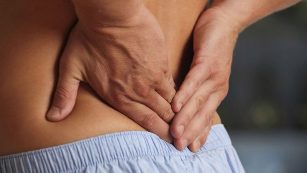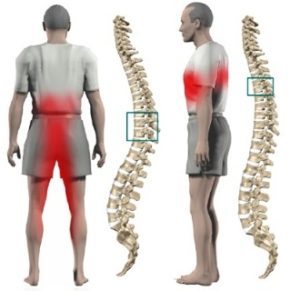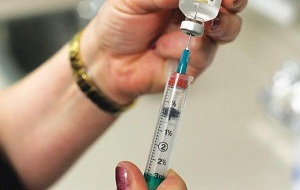This condition is characterized by the development of degenerative-dystrophic changes in the intervertebral discs, which spread over time to the ligaments and bone tissue of the vertebrae of the lumbar spine. An acute process, in the absence of treatment, inevitably turns into years.
Degrees of osteochondrosis of the lumbar spineDegenerative disease can turn a healthy person into a person with a disability.
Classification of 4 degrees of osteochondrosis of the lumbar region. The pattern of disease development is as follows:
First degree.Inside the fibrous ring, cracks form where the contents of the nucleus accumbens penetrate, causing irritation. This is the initial stage of osteochondrosis. The deformity of the intervertebral discs is just intense and gives reflex pain with sudden movements and heavy lifting. Unpleasant sensations in the lower spine can be mild and obvious:

- lumbodynia - local, persistent lumbar pain
- lumbago - sudden painful "lumbago" in the lower back.
Second degree.The destructive processes in the fibrous ring continue. The distance from one vertebra to the other is reduced, causing compression of the nerve fibers. There is discomfort in the lower third of the back, which from time to time develops into periods of pain.
Third degree.During this period, the final destruction of the fibrous ring occurs with the extrusion of the nucleus accumbens. Vessels and nerve endings are compressed by intervertebral discs. An intervertebral hernia forms. The spine is curved, forming:
- lordosis - arcuate deformity of the lumbar spine, with anterior wave of the spine
- kyphosis - the position opposite the lordosis, when the arc is formed in the outward direction.
- scoliosis - abnormal flexion of the spine to the right or left.
The last degreeosteochondrosis is considered the most serious and dangerous. At this time, the spine is already deformed, normal motor activity is lost. X-rays show bone growths in the lumbar spine - the body's response. The pain may be gone for a while, but that does not mean improvement. People with stage 4 osteochondrosis of the sacrum often become disabled. The reason is that at this stage the process is complicated.
Causes of osteochondrosis of the lumbar spine
Among the causes of bone osteochondrosis are the following:
- Disproportionate load on the spine.Humans are upright creatures, so in the upright position, the load on the spine is considered normal. When performing various actions, you must move, bend and bend. To keep the body in the desired state, the musculoskeletal system is in a state of prolonged tension. In the sitting position, the load on the spine increases, and when it is on the back, it becomes minimal. When a person is in a position for a long time, the lumbar and sacral spine are overloaded and the muscles do not rest, which causes discomfort first and then pain. This deforming factor creates the conditions for the development of osteochondrosis of the lumbar spine.
- Sedentary lifestyle.Contributes to the development of various pathologies, including those affecting the vertebral structures. Prolonged sitting causes deformity of cartilage tissue and reduction of muscle tone, causing the development of bone osteochondrosis.
- Excessive physical exercise.Both lack of intense physical activity and excess do nothing good for the musculoskeletal system. Long, hard work, especially related to lifting and carrying weights, leads to excessive pressure on the back muscles and causes the formation of spinal waxes.
- Posture disorders.Deformity of the discs between the vertebrae can be caused by improper walking. The reason is again the abnormal load on the spine. The intervertebral discs lose their elasticity, mobility and are therefore more likely to be damaged. More than others, older people suffer from similar problems.
- Bone defects, inherited pathologies, trauma and infectious lesions. Osteochondrosis is often the result of musculoskeletal disorders at birth. For example, when the cartilage tissues of the body are naturally fragile. In addition, pathologies of the spine develop after traumatic injuries and infectious processes, such as in osteomyelitis and tuberculosis.
- Flat feet.The signs of a "special" foot are the absence of a concave and sloping arch. Those who have such a feature often have problems with the spine. This is due to the increased load on the intervertebral discs when you walk. Throughout life, they are subject to increased physical stress during movement, so they wear out quickly
- Obesity.Being overweight is a problem and an extra burden on the body. All organs and systems suffer, including the spine.
- Pathological processes.Malfunctions of various structures can adversely affect the condition of the musculoskeletal system. Thus, the factors that cause osteochondrosis of the lumbar spine are endocrine disorders, cardiovascular problems and digestive system dysfunction.
- Wrong way of life.Many people do not pay enough attention to such simple and important things as physical activity, a balanced diet and normal sleep. An organism that exists for a long time under stress conditions weakens and is vulnerable. Other pathologies that can occur in such "fertile" soil include lumbar osteochondrosis.
Symptoms of osteochondrosis of the lumbar spine

Pathological changes in the lumbar spine are manifested by severe symptoms.
- Back painis the clearest "sign" of developing osteochondrosis. It speaks of the presence of "root syndrome", when the compression of the nerve endings of the spine causes pain in the lumbar region. The person becomes tired and irritable. Over time, simple and routine activity becomes a major problem due to low back pain. If an intervertebral hernia has formed in the lumbar region, the pain is transmitted to the lower leg, the back of the thigh and the leg. Over time, it becomes more and more difficult to sit and walk. Unpleasant sensations are not left even when lying down. Temporary relief may alternate with periods of deterioration.
- urinary tract dysfunction.Manifested by pain in the kidney area, frequent urge to urinate. The deformity of the intervertebral discs causes a displacement of the lumbar spine in relation to the sanctuary. This affects the work of the internal reproductive organs in women and in men causes problems with power.
- Decreased foot sensitivity in the foot area.It can be partial or absolute. At the same time, the reflexes of this part of the body weaken. Progressive pathology leads to complete loss of sensitivity of the lower extremities.
- gait disorders. Low back pain with osteochondrosis causes a person when walking to deviate in the opposite direction from where the nerve fibers are perforated. The situation does not allow walking long distances. A lame person is forced to stop from time to time, expecting pain relief. Early medical help can save a person from disability.
Treatment of osteochondrosis of the lumbar spine
Many people wonder if lumbar osteochondrosis is treated and how it occurs. When the diagnosis is made and the diagnosis is made, the treatment tactics are determined.
There are several methods used to treat bone osteochondrosis. Which of these is necessary and appropriate to apply to treat a disease or to alleviate a person's condition as much as possible, the doctor determines.
Someone is treated exclusively with folk remedies, at home, forgetting that they can be used only with a doctor's approval and only as part of a complex treatment.
Drugs for osteochondrosis
Medication includes the use of:
- tablet forms?
- injectable solutions?
- preparations for external use - ointments and gels.
Prescription drugs that eliminate inflammation and relieve pain in the lumbar spine. They can be used at home.

These could be:
- analgesics?
- non-steroidal anti-inflammatory drugs?
- drugs for muscle spasms (muscle relaxants);
- means cartilage tissue repair (chondroprotectors).
- corticosteroids (medicines containing hormones that work to relieve pain and inflammation)
- vitamins.
The course of treatment is prescribed by a doctor, who sometimes prescribes tablets or filters to calm the nervous system as an adjunct therapy.
Physiotherapy for lumbar osteochondrosis
Physiotherapy is another common method of relieving the symptoms of osteochondrosis. By acting on the spine and back, it enhances metabolic and restorative processes.
Usually prescribed:
- magnetic, laser and electrotherapy.
- phonophoresis?
- shock wave method?
- detector therapy?
- vibration massage?
- balneotherapy.
How many and which procedures will be required - the doctor decides.
Physiotherapy is effective when it comes to the early stages of pathology. But, like other types of treatment, it has contraindications. Therefore, when prescribing this method, the doctor takes into account many factors.
Therapeutic exercise for bone osteochondrosis
A set of physical exercises that can occur in lumbar osteochondrosis aims to restore the mobility of this spine.
Regularity is considered the main condition for its effectiveness. Exercises that are performed occasionally will not bring the desired result.
If the body already has complications caused by osteochondrosis, this method does not apply. In addition, contraindications for its use are serious pathologies of other organs and systems, as well as the presence of pain in the pelvic area and above.
Surgery for osteochondrosis of the lumbar spine
The surgical method is used in the presence of such serious complications as intervertebral hernia. The damaged intervertebral disc (discectomy) is partially or completely removed, as provided by the operation protocol.
Indications for surgery are:
- syndrome of severe and persistent pain, which can not be removed with medication for a month.
- the large size of the hernia and its effect on the spinal cord.












































